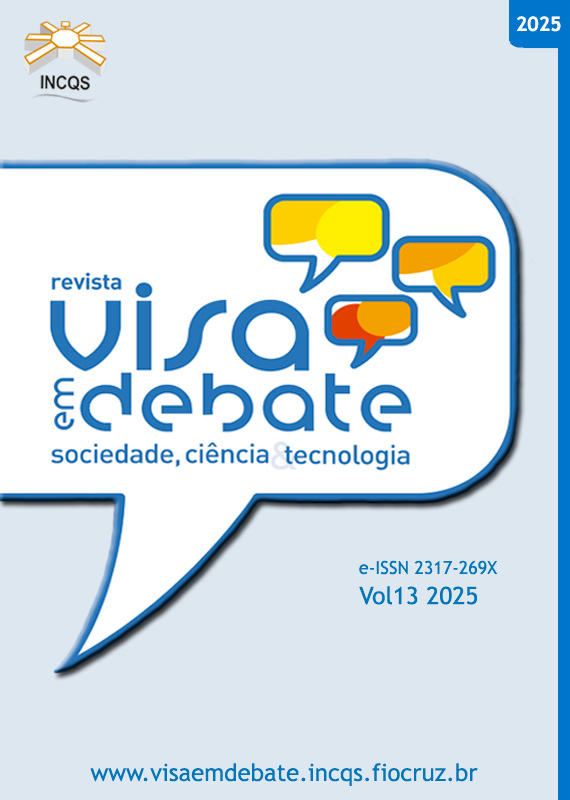Escherichia coli in foodborne outbreaks: Considerations on a Brazilian survey and bibliometric analysis
Vigil Sanit Debate, Rio de Janeiro, 2025, v.13: e02453 | Published on: 15/10/2025
DOI:
https://doi.org/10.22239/2317-269X.02453Keywords:
Food microbiology, One Health, Public Health, Food Safety, Foodborne diseasesAbstract
Introduction: Foodborne diseases (FBD) remain a significant public health issue in tropical and developing countries, primarily due to microbiological contamination. In Brazil, between 2014 and 2023, 6,874 outbreaks were recorded, resulting in 12,346 hospitalizations and 121 deaths—34.8% of which were associated with Escherichia coli (E. coli). Objective: This study aimed to consolidate and analyze the current scientific landscape related to E. coli in foodborne outbreaks in Brazil through a bibliometric review integrated with official epidemiological data analysis. Method: A search was conducted in the Scopus database, retrieving 65 documents, including 53 original articles, 10 reviews, one book chapter, and one letter to the editor. In addition, epidemiological data from the Brazilian Ministry of Health for the period 2014 to 2023 were assessed. Results: The analysis revealed a low national scientific output on the subject, limited international collaboration, and a concentration of publications in a few journals and institutions, particularly the University of São Paulo. The data also indicated weaknesses in the notification, surveillance, and sanitary inspection systems. Conclusions: The findings highlight the urgent need to improve epidemiological surveillance systems, with mandatory and standardized reporting, as well as increased investment in food inspection and public health education. The integration of bibliometric trends with epidemiological insights provides a comprehensive understanding of the existing research gaps and can support the development of more effective public policies for the prevention and control of FBD outbreaks caused by E. coli in Brazil.
Downloads
References
1. Oliveira FS. Epidemiological analysis of the bacterial profile involved in foodborne diseases (DTA) in the Northeast region of Brazil for the year 2019. Res Soc Develop. 2021;10(11):1-8.https://doi.org/10.33448/rsd-v10i11.19855
2. Gonçalves BVS, Barberini IR, Furtado SK. Epidemiological study on foodborne disease outbreaks in Brazil between 2008 and 2018. Scire Salut. 2022;12(2):335-48.https://doi.org/10.6008/cbpc2236-9600.2022.002.0035
3. Rani A, Ravindran VB, Surapaneni A, Mantri N, Ball AS. Trends in point-of-care diagnosis for Escherichia coli O157:H7 in food and water. Int J Food Microbiol. 2021:349.https://doi.org/10.1016/j.ijfoodmicro.2021.109233
4. Warmate D, Onarinde BA. Food safety incidents in the red meat industry: a review of foodborne illness outbreaks linked to the consumption of red meat and its products, 1991 a 2021. Int J Food Microbiol. 2023;398:1-16.https://doi.org/10.1016/j.ijfoodmicro.2023.110240
5. Amaral SMB, Almeida APF, Silva FS, Silva YYV, Damaceno MN. Overview of foodborne disease outbreaks in Brazil from 2009 to 2019. Recima21. 2021;2(11):1-16.https://doi.org/10.47820/recima21.v2i11.935
6. Marques PRC, Trindade RVR. Epidemiological overview of foodborne disease outbreaks between 2000 and 2021 in Brazil. Rev Multidisc Saúde. 2022;3(3):1-10.https://doi.org/10.51161/rems/3477
7. Ministério da Saúde (BR). Surtos de doenças de transmissão hídrica e alimentar informe: 2024. Brasília: Ministério da Saúde; 2024 [access feb 4, 2025]. Available from: https://www.gov.br/saude/pt-br/assuntos/saude-de-a-a-z/d/dtha/publicacoes/surtos-de-doencas-de-transmissao-hidrica-ealimentar-no-brasil-informe-2024/
8. Marques PRC, Trindade RVR. Panorama epidemiológico dos surtos de doenças transmitidas por alimentos entre 2000 e 2021 no Brasil. Rev Mult Saúde. 2022;3(3):1-10.https://doi.org/10.51161/rems/3477
9. Akter S, Rahman MA, Ashrafudoulla M, Park SH, Ha S. Seafood and biofilm: mitigation strategies for food safety. Food Control. 2025;168.https://doi.org/10.1016/j.foodcont.2024.110932
10. Singh VK, Singh P, Karmakar M, Leta J, Mayr P. The coverage of the journals Web of Science, Scopus and Dimensions: a comparative
analysis. Scientometrics. 2021;126(6):5113-42.https://doi.org/10.1007/s11192-021-03948-5
11. Rogers G, Szomszor M, Adams J. Sample size in bibliometric analysis. Scientometrics. 2020;125(1):777-94.https://doi.org/10.1007/s11192-020-03647-7
12. Silva R, Rocha RS, Ramos GLPA, Xavier-Santos D, Pimentel TC, Lorenzo JM et al. What are the challenges for ohmic heating in the food industry? Insights from a bibliometric analysis. Food Res Int. 2022;157.https://doi.org/10.1016/j.foodres.2022.111272
13. Batista JDS, Soares LS, Oliveira LLF, Baldoni NR, Chequer FMD. Food and beverage poisoning and occurrence of waterborne and foodborne diseases in Brazil. Saúde Pesq. 2022;15(4):1-21.https://doi.org/ 10.17765/2176-9206.2022v15n4.e11170
14. Ministério da Saúde (BR). Doenças de transmissão hídrica e alimentar (DTHA). Brasília: Ministério da Saúde; 2020[access feb 4, 2025]. Available from: https://www gov.br/saude/en-br/assuntos/saude-de-a-z/d/dtha
15. Kim E, Kim BI. Characteristics and related factors of waterborne and foodborne infectious disease outbreaks before and after the onset of the COVID-19 pandemic (2017-2021) in the Republic of Korea: a descriptive study. Osong Public Health Res Persp. 2023;14(6):483-93.https://doi.org/10.24171/j.phrp.2023.0221
16. Ministério da Saúde (BR). Vigilância epidemiológica das doenças de transmissão hídrica e alimentar: manual de treinamento. Brasília: Ministério da Saúde; 2021[access feb 4, 2025]. Available from:https://www.gov.br/saude/pt-br/centrais-de-conteudo/publicacoes/svsa/doencas-transmitidas-por-alimentos-dta/manual_dtha_2021_web.pdf/
17. Souza JF, Souza ACF, Costa FN. Estudo retrospectivo de surtos de doenças transmitidas por alimentos no Nordeste e Estado do Maranhão, de 2007 a 2019. Pesq Soc Des. 2021;10(1):1-8.https://doi.org/10.33448/rsd-v10i1.11728
18. Abebe E, Gugsa G, Ahmed M. Review on major zoonotic foodborne bacterial pathogens. J Trop Med.2020;2020:1-19. https://doi.org/10.1155/2020/4674235
19. Foster-Nyarko E, Pallen MJ. The microbial ecology of Escherichia coli in the vertebrate gut. FEMS Microbiol Rev. 2022;46(3):1-22.https://doi.org/10.1093/femsre/fuac008
20. Pakbin B, Brück WM, Rossen JWA. Virulence factors of enteric pathogenic Escherichia coli: a review. Int J Mol Sci. 2021 Sep 14;22(18):9922.doi: 10.3390/ijms22189922.
21. Bonten M, Johnson JR, van den Biggelaar AHJ, Georgalis L, Geurtsen J, Palacios PI et al. Epidemiology of Escherichia coli bacteremia: a systematic review of the literature. Clin Infect Dis, 2021;72(7):1211-19.https://doi.org/10.1093/cid/ciaa210
22. Nascimento MSG, Costa MFB, Moraes VS, Silva ECC, Pinto ABSS, Ramos GLPA. A importância do controle microbiológico de alimentos. Open Sci Res. 2023;11:25-33. https://doi.org/10.37885/230412820
23. Lima ACD, Resgalla Junior C, Silva MAC. Evaluation of the antimicrobial resistance profile in strains of Escherichia coli and Staphylococcus spp. in the Marambaia canal in Balneário Camboriú, Santa Catarina. Vigil Sanit Debate. 2022;10(3):1-11. https://doi.org/10.22239/2317-269x.02026
24. Okumu NO, Ngeranwa JJN, Muloi DM, Ochien L, Moodley A, Mutisya C et al. Risk factors for diarrheal Escherichia coli infection in children aged 6-24 months in peri-urban community, Nairobi, Kenya. Plos Glob Public Health. 2023;3(11):1-16.https://doi.org/10.1371/journal.pgph.0002594
25. Zhang J, Xu Y, Ling X, Zhou Y, Lin Z, Huang Z et al. Identification of diarrheal Escherichia coli by a new multiplex PCR assay and capillary electrophoresis. Molec Cell Prob. 2020;49.https://doi.org/10.1016/j.mcp.2019.101477
26. Martínez Abdalla SE, Abia ALK, Amoako DG, Perrett K., Bester LA, Essack SY. Food animals as reservoirs and potential sources of multidrug-resistant diarrheagenic E. coli pathotypes: focus on intensive pig farming in South Africa. Onderst J Vet Res. 2022;89(1):e1-13.https://doi.org/10.4102/ojvr.v89i1.1963
27. Enciso-Martínez Y, González-Aguilar GA, Martínez-Téllez MA, González-Pérez CJ, Valencia-Rivera DE, Barrios-Villa E et al.Relevance of tracking the diversity of Escherichia coli pathotypes to reinforce food safety. Int J Food Microbiol. 2022;374.https://doi.org/10.1016/j.ijfoodmicro.2022.109736
28. Niveditha A, Pandiselvam R, Prasath VA, Singh SK, Gul, K, Kothakota A. Application of cold plasma and ozone technology for decontamination of Escherichia coli in food: a review. Food Control. 2021;130.https://doi.org/10.1016/j.foodcont.2021.108338
29. Pang S, Wu W, Liu Q. Different serotypes of Escherichia coli flagellin exert identical adjuvant effects. BMC Vet Res. 2022;18(1):1-10.https://doi.org/10.1186/s12917-022-03412-3
30. World Health Organization – WHO. E. coli. Geneva: World Health Organization; 2018[access nov 3, 2024].Available from: https://www.who.int/news-room/fact-sheets/detail/e-coli
31. Furlan JPR, Ramos MS, Santos LDR, Rosa RS, Stehling EG. Multidrug-resistant Shiga toxin-producing Escherichia coli and hybrid pathogenic strains of bovine origin. Vet Res Comm 2023;47(4):1907-13.https://doi.org/10.1007/s11259-023-10141-x
32. Bolívar A, Saiz-Abajo MJ, García-Gimeno RM, Petri-Ortega E, Díez-Leturia M, González D et al. Cross-contamination of Escherichia coli
O157:H7 in minimally processed leafy vegetables: derivation of a food safety objective and other risk management metrics. Food Control. 2023;147.https://doi.org/10.1016/j.foodcont.2022.109599
33. Ministério da Saúde (BR). Síndrome hemolítico-urêmica. Brasília: Ministério da Saúde;2024[access feb 4, 2025].Available from: https://www.gov.br/saude/pt-br/assuntos/saude-de-a-a-z/s/shu
34. Pakbin Costa LRM, Garcez Buiatte AB, Dias SC, Garcia LNH, Cossi MVC, Yamatogi RS et al. Influence of animal production systems on the presence of pathogenic strains of Escherichia coli in the bovine production chain. Food Control. 2024;157.https://doi.org/10.1016/j.foodcont.2023.110155
35. Joseph A, Cointe A, Kurkdjian PM, Rafat C, Hertig A. Shiga toxin-associated hemolytic uremic syndrome: a narrative review. Toxins. 2020;12(2):1-46.https://doi.org/10.3390/toxins12020067
Downloads
Published
Issue
Section
License
Copyright (c) 2025 Health Surveillance under Debate: Society, Science & Technology

This work is licensed under a Creative Commons Attribution 4.0 International License.
COPYRIGHT ALLOWANCE The author (s) hereinafter designated as the ASSIGNOR hereby assign and transfer, free of charge, the ownership of the copyrights related to this ARTICLE to the Vigilância Sanitária em Debate: Sociedade, Ciência & Tecnologia (Health Surveillance under Debate: Society, Science & Technology) – Visa em Debate, represented by FUNDAÇÃO OSWALDO CRUZ, established at Av. Brasil, nº 4365, Manguinhos, Rio de Janeiro, RJ, Brazil, CEP 21045-900, under the conditions set out below: (a) The terms and conditions set forth in this Agreement shall apply to the following: 1. The ASSIGNOR declares that they s(he) is (are) the author (s) and owner (s) of the copyrighted property of the ARTICLE submitted. 2. The ASSIGNOR declares that the ARTICLE does not infringe the copyrights and / or other property rights of third parties, that the disclosure of images (if any) has been authorized and that they s(he) assume(s) full moral and / or property liability for its content, before third parties. 3. THE ASSIGNOR assigns and transfers all copyrights relating to the ARTICLE to the ASSIGNEE, especially the rights of editing, publication, translation into another language and reproduction by any process or technique. The ASSIGNEE becomes the exclusive owner of the rights related to the ARTICLE, and any reproduction, totally or partially, is prohibited in any other means of publicity, printed or electronic, without prior written authorization from the ASSIGNEE. 4. The assignment is free and, therefore, there will be no remuneration for the use of the ARTICLE by the ASSIGNEE.







